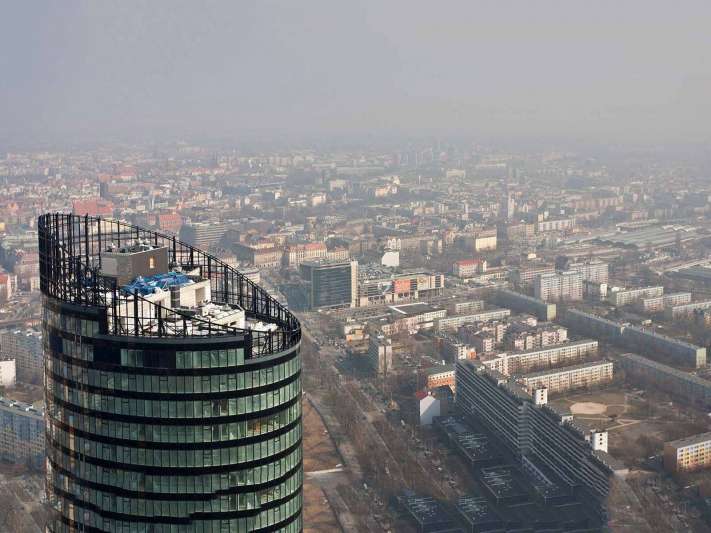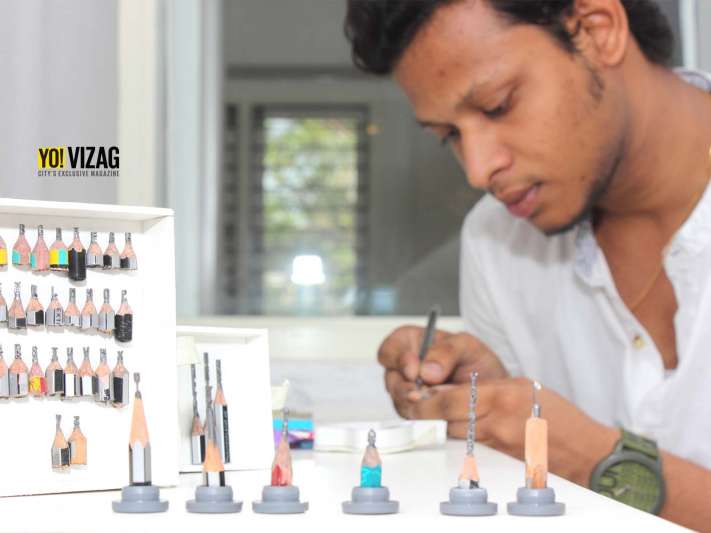Visakhapatnam and its surrounding districts are richly endowed with ancient temples and religious festivals. Visakhapatnam was ruled by perhaps all the key ruling dynasties of the erstwhile era. There are umpteen temples, impressive churches, very old dargahs and ancient Buddhist sites within and bordering to Vizag. Religiously inclined tourism is just an offshoot of pilgrimages of yore. But, travelling to temples and seeking the blessings of the Gods is only one aspect of religious tourism. For some, it is the history, heritage aspect and sculpture of the temples that is more intriguing. Furthermore, many tourists are fascinated by the gaiety and pomp that marks religious festivals. Irrespective of the quest, be it seeking blessings, admiring the artistry of the sculptors or revering the heritage structures, the Vizag belt has it all.
Simhachalam Temple
The most prominent shrine in Vizag is an ancient Vaishnava temple, the Simhachalam Temple dedicated to Lord Varaha Lakshmi Narasimha. Significant here is that the idol here represents both the Varaha and Narsimha incarnations of Lord Vishnu. Situated atop lush, dotted with trees of the famed ‘Simhachalam Sampangie’ the sweet-smelling yellow Champa flower, the temple is only 18 km from Visakhapatnam station and 10 km from the airport. With over 525 inscriptions on the temple walls, the oldest dates back to the Chola King Kulothunga, 1098 AD. There are also references to Sri Krishna Devaraya who donated ornaments and land to the Lord. There is extensive use of both Chalukyan and Orissa architecture styles. The idol is perpetually covered with Sandalwood paste which is replaced every year on Akshaya Tritiya, popularly called the ‘Chandana Utsav’, the only day in the year that the Lord can be viewed with only a thin single coat of sandalwood paste, the ‘Nijarupa Darshan’.
Tip: Embracing the Kappastambam, a pillar just next to the main shrine, and praying is said to fulfil the devotee’s wish.
Sri Kanakamahalakshmi Temple
Perhaps the most popular shrine in the packed narrow by-lanes of One Town area in Vizag city, the Sri Kanaka Mahalakshmi temple draws massive crowds in the Telugu month, Magasira Masam, especially on Thursdays. According to hearsay, the idol, a form of Lakshmi Devi was the family deity of the then ‘Rajas of Visakhapatnam’, lost for reasons unknown. Centuries later, in 1912, the idol was recovered from a well and installed subsequently. The speciality of this temple is that though there is a big roofed hall, the idol itself has no roof above; it is exposed to the vagaries of nature. This, according to locals is what the Goddess had desired. Devotees bring newly born babies for blessings and newlyweds to make a beeline for the temple. A visit here showcases some of Vizag’s oldest and busiest lanes.
The Holy Hills accentuating communal harmony
As a unique testament to the communal harmony of Vizagites, there are three picturesque hillocks each with its own distinctive religious significance along the channel that leads to the inner harbour. There is The Venkateswara Temple on the ‘Sringamani Hillock’, The Ross Hill Church on the ‘Ross Hill’, and The Baba Ishq Madina Dargah on the ‘Dargah Konda’. While the Dargah is about 700 years old, the temple is more than two centuries old. The Ross Hill Church too is more than a century old…emphasising the quaint essence of spiritualism, that ‘all religions are but the branches of the same tree’. The port-channel, the entrance of the inner harbour for ships and liners can be seen from these hilltops, located just 1 km from the Old Post Office in the Port Area. On the other side of the channel lies the path to Sagar Durga temple, Yarada Beach and the Light House.
The Ross Hill Church (Ross Hill):
The central and the highest hill amongst the three, is named after a local Judge, Monsieur Ross who built a house on it in 1864. In 1866, the then Bishop Msgr J.M. Tissot acquired the bungalow and on August 15, 1867, an altar was erected and blessed as a chapel.
The Church has since undergone many renovations to accommodate the increasing number of devotees. The annual feast of the Immaculate Conception and procession to the top of the Ross hill, from St. Aloysius School on the evening of every 8th December has become an integral part of Vizag Culture.
Lord Venkateswara Temple:
Legend has it that in late 17th century, a Dutch Ship commandeered by European Captain Blackmoor was prevented from being pulled back into the choppy sea waters in the severe cyclonic storm by what was presumed to be a big ‘boulder’ which turned out to be an idol of Sri Lord Venkateswara. The idol was reverently installed the idol on the stately Sringamani Hill overlooking the harbour.
The Baba Ishq Madina (Dargah Konda):
This mosque and mausoleum of the Muslim saint, Baba Ishaq Madina was constructed on the orders of King Aurangzeb after his visit here about 700 years ago. The saint was revered for his prophecies, miracles and venerated by Hindu and Muslim devotees alike. The local ‘Pirs Festival’ here attracts a large number of not only Muslim devotees but faithful Hindus too.
Vizianagaram
A village deity, a thousand-year-old temple, and a village with a huge complex of temples; such is the variety that Vizianagaram offers. Just 40 km northwest of Vizag city, this royal city has much to showcase.
Paiditalli Ammavari Temple, Vizianagaram
Vizianagaram is 40 km northwest of Visakhapatnam. The most popular temple here is the Paiditalli Ammavari Temple (near the Vizianagaram railway station). Considered to be the grama devata (village deity) of Vizianagaram, the goddess is believed to be a member of the Vizianagaram royal family, the king’s sister. Legend has it that as the king was battling, his sister was trying to meet him, when she heard the news regarding his demise. Distraught, the sister fainted and then subsequently died. Before dying, she told her assistant where her idol could be found, accordingly, the idol was found, on the first Tuesday after Vijayadashmi. Since then on every year on the first Tuesday after Dussehra, the temple festival, Sirimanu Utsav is celebrated.
Jammi Vruksham
Legend has it that the Pandavas hid their weapons on a “Jami Tree” here before embarking on the final year of their exile. Located in Jammi on the banks of the river Gowthami, 10 km from Vizianagaram, the idols in this temple were supposedly installed by King Dharmaraj (of the five Pandavas) and Kunthi. The temple is said to be thousands of years old and geologists estimate that the Sivalinga extends more than 179 feet deep into the earth.
Kumili
20 km away from Vizianagaram is a small village, Kumili which is famous for its thirteen temples, a huge complex of temples built by local devotees and well-organized streets. The temples are unique with extremely attractive sculptures, paintings on the walls and idols. In the same village, there are also the ruins of the mud forts belonging to the erstwhile Vizianagaram kingdom.
Ramatheertham
Ramathirtham, a 1000 years old Sri Rama temple is situated on the Bavikonda hill, 13 km from Vizianagaram. This temple is built entirely on a huge rock. In these hills, there are also vestiges of Jainism and natural caves to be found. On the southernmost hill stand the Rama temple, the northern hill known as Durgakonda is named after goddess Durga whose statue is in a natural cave. The central hill known as Gurubhaktakonda contains a number of Buddhist structures like the remains enormous Buddhist Mahasthupa, 19 feet high and 65-meter diameter.
Srikakulam
Usually, in South India, there is no village without a temple. Be it any deity, God or goddess, but a temple is almost obligatory. About 100 km from Vizag, Srikakulam is home to some of the most revered and unique temples in India. Ancient and steeped in tradition, these temples give you the feeling of being one with the Divine almighty.
Arasavalli Sri Suryanarayana Swamy Temple, Srikakulam
Just a kilometre from Srikakulam Town and about 105 km from Vizag the Arasavalli temple is the only Sun God temple in India where prayers, rituals and festivities for the Sun God continue till date. The locals believe that Sage Kasyapa installed the idol of Surya here for the welfare of mankind. The construction of the temple is also attributed to the Kalinga King, Devendra Verma during the latter half of the 7th century. The ‘sthalapuranam’ narrates that it is Lord Devendra who incurred the wrath of Nandi and according to divine instructions installed the idol of the sun as a penance. A unique feature of this temple is that during the months of March and September the early morning sun rays actually caress the feet of the presiding deity. Ratha Saptami (Jan/Feb) is celebrated with great pomp here as well as Kalyanotsavam, Ksheerabdi Dwadasi Teppa Tirunallu, Kamadahanostavam and Dolostvam.
Sri Kurmam Temple, Srikakulam
Believed to be built before the 2nd century, the Sri Kurmanadha temple in Srikurmam, 118 Km from Vizag (12 km from Arasavalli) is the only temple in India depicting Lord Vishnu in the Kurma avatar. The idol is presumed to be the fossil of an actual Tortoise. Each of the 200 plus pillars are exclusive masterpieces in art.
Tip: Check out the Yoga Narsimha Swamy Temple in the same village.
East Godavari
The famed Annavaram temple, Pithapuram, Drakshramam, Ryali… the temples of East Godavari District are innumerable and too many to list. Nevertheless, we have attempted to list some highly renowned ones, full of history and believed to be installed by the Gods themselves. Easier accessed from Samalkota (about 150 km from Vizag) or Rajahmundry (about 200 km from Vizag) or, a weekend stay there will allow one to cover all the main temples around. And if time is at hand, then even the famed Bhadrachalam Temple on the west bank of the river Godavari can be covered, a trip which includes including an enjoyable boat ride in a well-furnished house-boat from Rajahmundry.
Sri Satyanarayana Swamy Temple, Annavaram
Annavaram literally means the place where the Lord grants boons. This temple atop the Ratnagiri hill at 125 km from Vizag on NH 5 is dedicated to Sri Satyanarayana Swamy. This form of Lord Vishnu is venerated by married couples with the Satyanarayana Vratam puja. This temple witnesses thousands of marriages every year. Kalyanotsavam, Teppotsavam Bhishma Ekadasi and Vysakha Ekadasi are among the main events at the temple. Under “Nitya Annadanam Scheme” conducted by the temple authorities, thousands are provided with food daily. Built by the local Zamindar, who having been ordained by the Lord in his dream, traced the idol on the hill and installed it in 1891. The main temple constructed in the form of a chariot with the four wheels at each of the four corners. An interesting feature to check out here is the solar clock within the temple precincts. There is also a temple of Sri Rama and the shrines of Vana Durga and Kanaka Durga nearby. Boat rides are conducted in the Pampa River flowing next to the pious hill.
Sri Kukkuteswara Swamy Temple, Pithapuram
Pithapuram in East Godavari District is an ancient town, about 140 kilometres from Vizag. There is a 10th-century temple complex which houses temples dedicated to Sri Kukkuteswara Swamy (a Siva lingam), Sri Puruhutika Devi (Goddess Raja Rajewari) – a Shakti Peetham( one among the “ Astadasa Shakti Peetham”), Sri Rama, Kumaraswamy, Venkateswaraswamy, Venugopalaswamy and Kunti Madhava Swamy. In addition to being a Shakti peetham, this temple compound also has the legendary Padagaya tank. Sri Kukkuteswara Swamy is in the form of a 2 ft high Swayambhu Sivalingam made of white marble stone. The linga resembles the back of cock; hence called Kukkuteswaraswamy. Vyasa is said to have worshipped here. According to Puranas, Sati‘s organ fell here when Lord Vishnu cut the corpse borne by Siva after Dakshasamhara. Accordingly, the Devi Puruhutika temple is a Shakti peetham. Furthermore, as per legend, Kunti installed the idol in the Kunti Madhavaswamy temple. This deity is said to have been worshipped by Vyasa, and Valmiki and Agastya in the past. Annual festivals celebrated here are different for different deities like Maghabahula Ekadasi for Kukkuteswara, Suddha Ekadasi for Kunti Madhava, Phalguna for Kumaraswamy and Karthikamasa for Venugopala Swamy.
SriKumararama Bhimeswaraswamy Temple, Samalkot
Approximately 150 km from Vizag, on the way towards Rajahmundry, in Samalkot there is an ancient temple, one amongst the five Pancharamas, built by the Chalukyas in 892 AD. This temple is identical to the Draksharama temple (near Rajahmundry) another one of the Pancharamas. This temple is also a national heritage site. Lord Siva here blesses devotees in ‘Yoga Mudra’. The Siva Linga here is 14 feet high and the temple is a two-tier structure where regular rituals and prayers are done on the first floor of the temple. The Kakatiya rulers during 1340-1466 AD extensively beautified and renovated the temple with polished pillars adorned with intricate artwork.
Sri Bhimeswaraswamy Temple, Draksharama
Sri Bhimeswaraswamy Temple in Draksharama, close to Rajahmundry is a famed Pancharama temple. About 180 Kilometres from Vizag, this temple is very similar to the Samalkota Temple. Built by the Eastern Chalukyas during the 9th Century AD, within the temple is also the Goddess Manikyabamba, making this temple one among the 18 Shaktipeethas. Skanda Purana makes extensive mention about Draksharama. The white Sivalingam is about 9 feet high. Free food is served to the pilgrims and a rest house or choultry nearby provides accommodation. Sivaratri and other festivities attract huge crowds.
Sri Someswara Swamy temple, Kotipalli
Sri Someswara Swamy temple on the banks of Godavari River in Kotipalli (60 km from Rajahmundry) is a 13th Century Lord Siva temple. The lingam here is believed to be installed and worshipped by Lord Indra, Lord Chandra and Kasyapa Maharshi. Lord Indra founded Koteswara Lingam along with Ammavaru. Lord Chandra established Someswara Lingam with Raja Rajeswari Ammavaru. And the Siddhi Janardhana Swamy along with Sridevi and Bhudevi were established by Kasyapa Maharshi. The river is said to be brought here by Gowtham Maharshi. The Koti Teertha Kshetram here, with a number of water currents flowing in these waters, is considered holy and dip in this Goutami river is believed to wash away sins.
Lord Sri Lakshmi Narasimha Swamy Temple, Antarvedi
Antarvedi, where the mighty Vasishta Godavari pours into the sea is famous for the 16th century AD temple of Lord Lakshmi Narasimha Swamy Varu and the Siva temple referred to as Dakshina Kasi. 100 km from Rajahmundry, the Narsimha temple is among the 9 Narsimha Khsetras in the country. Antarvedi is also known as Sapta Sagara Sangama Pradesam, the last and the most important of the seven sacred bathing places.
Sri Uma Kamandalesara Swamy Varu, Ryali
Ryali, 40 Kms from Rajahmundry by road is famous for the 11th century Chola King Raja Vikrama Deva constructed the temple for Jagan Mohini (a Vishnu incarnation) on the divine instructions from the Lord. The five feet three inches tall beautiful black stone idol is believed to be a swamyambhu idol. The frontal side depicts Lord Mahavishnu, while from behind, it resembles a beautiful lady, the Mohini incarnation of Vishnu. This temple is surprisingly popular with officers desiring transfers. A very rare feature is observed at Ryali, here Vishnu and Lord Siva Temples face each other. The ancient Siva temple is Sri Uma Kamandalesara Swamy Varu. The lingam said to have been consecrated by Lord Brahma with his Kamandalam. It is believed that the Lord in this temple ensures that none of the surrounding villages ever suffer from drought, even in times of acute scarcity.
Sri Mandeswara Swamy Temple, Mandapalli
Sri Mandeswara Swamy Temple (Saneeswara Swamy Temple) is in Mandapalli Village near Ravulapalem, about 38 km from Rajahmundry. This Siva temple is revered as the Saneeswara Temple on Saturdays. According to legend, Lord Sani punished the demons Aswadha and Pippale and annihilated them after a yearlong battle. To absolve himself from this sin (Brahmahatya dosha), He, on the advice of Maharishis installed and worshipped the Sivalinga here. Lord Siva pleased with the prayers of Lord Shani declared that whosoever worships Him on Saturdays with gingelly oil (til/sesame Oil) and other items that please Lord Sani, will be freed from the Sani Dosha of any kind. Thousands of devotees visit the temple especially on Saturdays and offer prayers to get relief from Sani Dosha or Elinati Shani dosha. It is a rare and unique temple for Lord Sani in the entire Andhra Pradesh.











